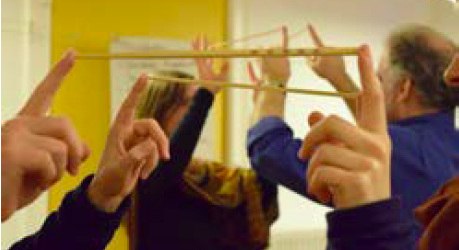
Summary
This exercise serves as an opener to introduce and reflect on the topic of leadership in organisations, personal preferences and characteristics in a leadership position, as well as what leadership means for a team. It can also be used as an energiser.
Goal/Learning Objective/Expected Output
The participants personally experience aspects of leading another person, triggering reflection about what it means to be leading others as well as to be led.
Way/level of dealing with subject
Experimentation and reflection.
Application in moderation cycle
Divergence
Duration
15 to 30 minutes including debriefing.
Group size
6 participants as a minimum, but it can also be done in big groups of 30 to 40 people, provided that the room is big enough for the number of participants to move freely around the room.
Level of difficulty
Easy
Facilitator
This exercise can be done by both internal and external facilitators. The actual exercise is very simple and does not need a lot of explanation. The most important part is the debriefing afterwards which involves creating the space from which participants can draw deeper meanings from the exercise.
Materials needed
- The same number of chopsticks as there are participants.
Additional resources:
- Enough space to move freely.
Process description
Participants form pairs (if the number of participants is uneven the facilitator participates in the exercise) who face each other.
Each pair is given two chopsticks. The task is to hold the two chopsticks in the air by both pressing their index fingers against one end of the chopstick. Then the pairs are asked to move around the room without letting the chopsticks fall down to the floor – and without talking to each other.
The exercise is done in three rounds.
During the first round of approximately 2–3 minutes, one person takes responsibility for not letting the sticks fall to the floor.
In the second round, the other person takes on that role.
During the third round both partners agree to share the responsibility of not letting the chopstick fall to the floor while moving around the room.
Debriefing options
There are a lot of insights that can be gained from the debriefing of this exercise and by drawing the basic link to leadership. The first is that there are individual differences in how comfortable people feel in the role of leader or someone who is being led. For some people it might be very difficult to give up control and completely tune into the non-verbal communication with their partner. It’s also interesting to compare the different approaches towards leading the other – whether it’s by eye contact or mainly by pressure – or if the collaboration at some point turns into a dance-like movement where pairs gently and creatively explore new ground.
Another difference to explore is the experience of leading alone or feeling a shared responsibility.
About the general nature of leadership, this exercise offers the reflection that leadership can only work with the support and consent of those who are led: it is always a joint endeavour.
Secondly, a basic level of resistance by those who are led is essential for leaders as orientation and source of information, as well as to establish some kind of balance. Without any resistance, guidance easily pushes over limits and becomes ineffective. This exercise is thus an excellent way to start reflection and discussion about how leadership works in an organisation, highlighting the collective not merely the individual responsibility that is actually behind it.
The debriefing can then also be used to connect with a theoretical framework for dividing authority and responsibility between leaders and team.